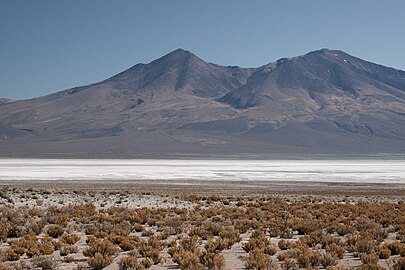Tomasamil
| Tomasamil | |
|---|---|
 Laguna Hedionda with the mountains Cañapa (left) and Tomasamil (right). | |
| Highest point | |
| Elevation | 5,890 m (19,320 ft)[1] |
| Prominence | 1,590 m (5,220 ft)[2] |
| Listing | Ultra |
| Coordinates | 21°18′S 67°58′W / 21.300°S 67.967°WCoordinates: 21°18′S 67°58′W / 21.300°S 67.967°W |
| Geography | |
 Tomasamil Bolivia | |
| Location | Potosi, Bolivia |
| Parent range | Cordillera Occidental |
Tomasamil (Spanish: Cerro Tomasamil) is a highly eroded dormant volcano in south-west Bolivia, at the edge of the Atacama Desert of coastal Chile. It is also located 6 km east of Ollagüe, another extinct Ultra on the Chile-Bolivia border. Due to its location, the peak of Tomasamil often has little to no snow, and the area around the mountain is usually dominated by pockets of occasional shrub and exposed dirt, along with expansive salt flats, typical of the region it is located in. The peak of Tomasamil itself is made out of exposed dry rocks. However, this is a relatively recent phenomenon, as in previous years Tomasamil usually had enough precipitation for the now dry and exposed peak to be snow-capped. It is approximately located 197 km south-west of the famous Salar de Uyuni salt flats[3] and is also relatively close to the in the general area, but is closer to the city of Potosí. Near the lower parts of Tomasamil, animals such as the vicuña, a relative of the llama, and plants such as the yareta, which are a moss-like plant found on high elevation areas of the tripoint between Chile, Bolivia and Argentina.[4]
Gallery[]

An example of a yareta plant found in Lauca National Park, Chile

Salar de Chiguana
See also[]
References[]
- ^ Topographic map Cerro Araral, Chile; Bolivia SF-19-7, Joint Operations Graphic 1:250,000, U.S. National Imagery and Mapping Agency
- ^ "Bolivia Ultra-Prominences". Peaklist.org. Note: Prominence value from this source is based on an elevation of 5,830 m. Retrieved 2013-02-25.
- ^ "Cerro Tomasamil: Climbing, Hiking & Mountaineering : SummitPost".
- ^ Kleier, Catherine; Rundel, Philip W. (August 2004). "Microsite requirements, population structure and growth of the cushion plant Azorella compacta in the tropical Chilean Andes". Austral Ecology. 29 (4): 461–470. doi:10.1111/j.1442-9993.2004.01386.x.
External links[]
- Mountains of Potosí Department


